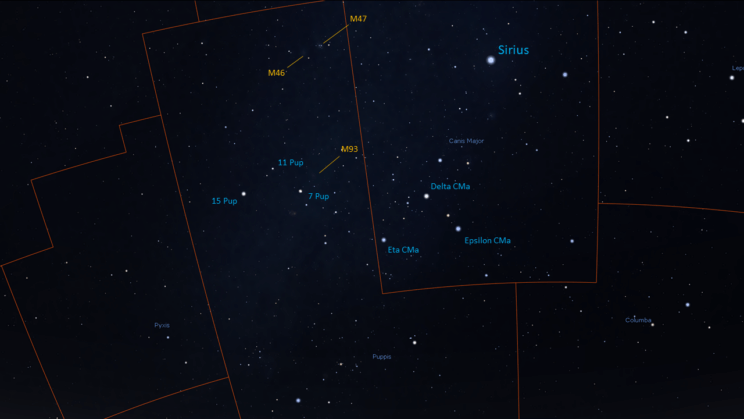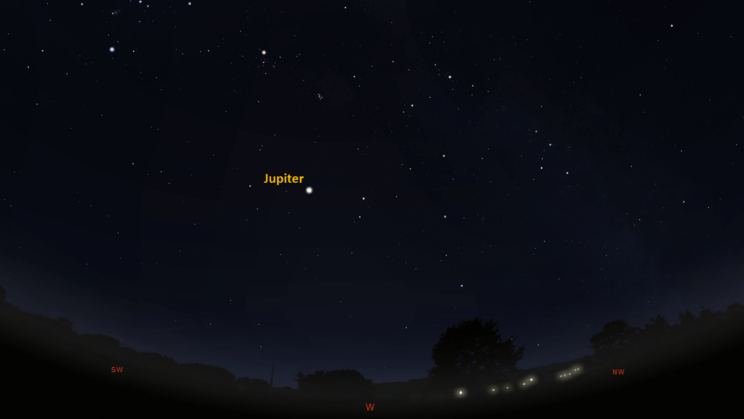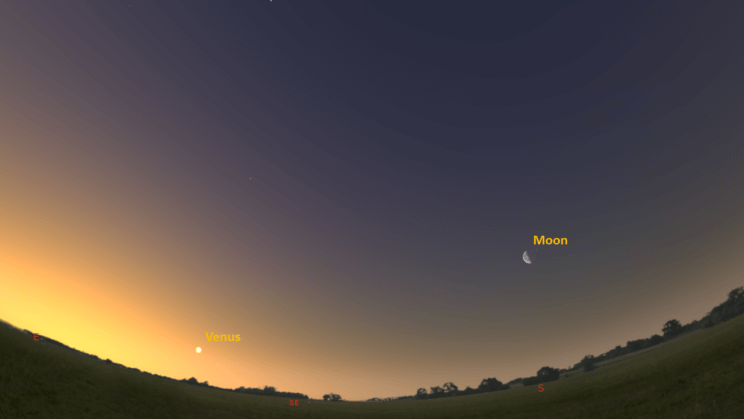This is the Saint Louis Science Center’s NIGHT SKY UPDATE for the week of Saturday, March 2, 2024.
Information updated weekly or as needed.
Times given as local St. Louis time which is Central Standard Time (CST). For definitions of terminology used in the night sky update, click the highlighted text. If relying on times posted in Universal Time (UT), St. louis is -6 hours when CST.
Join us for our next star party, Friday, April 5, 2024, held in association with the St. Louis Astronomical Society. For details, see the information at the bottom of this page or visit https://www.slsc.org/explore/mcdonnell-planetarium/public-telescope-viewings/
Observing Highlight of the Week

The map above indicate the location of the constellation Puppis and several objects seen within it. Look for this section of sky in the south around 8 pm over the next week. Map created using Stellarium.
This week we will highlight a lesser-known constellation called Puppis. Puppis was originally part of the constellation Argo Navis which was meant to be the legendary boat of Jason and the Argonauts according to Greek folklore. Argo Navis was included in the 48 constellations listed by Ptolemy in his famed Almagest which was written around 150 CE. Several centuries later, French astronomer Nicolas Louis de Lacaille broke the large constellation into three constellations called Carina, Vela and Puppis. These were first introduced in 1763 and are still used today.
Puppis represents the poop deck of the ship. It is best seen from equatorial and southern latitudes due to its southern declination, however Puppis is easily seen from St. Louis during winter months. To find Puppis, look south this week for the bright star Sirius around 8 pm. It is the brightest star visible to us at night so it will be easy to identify. Sirius is part of the constellation Canis Major which is found southeast of Orion. If you look south of Sirius, you will find three bright stars in a small triangle shape. These stars are Delta, Eta and Epsilon CMa. Once you can find these stars, look about 9° east and you will find a similar but smaller triangle shape of stars. These stars are 7, 11, and 15 Pup which are three of the brightest stars we see in Puppis. Due to its southern declination, parts of the constellation extend south of our horizon. Generally, the areas due east and south of Canis Major represent the portions of Puppis visible to us.
Found along the winter section of the Milky Way, Puppis is home to several open star clusters within reach of binoculars. Open star clusters are groups of a few tens to thousands of stars that formed together from the same molecular cloud of gas and dust. Open star clusters are found in irregular and spiral galaxies but not in elliptical galaxies. Stars in open star clusters are more spread out than globular clusters, so the cluster is not very stable, and members eventually disperse. Currently, astronomers know of roughly 1,100 open star clusters in the Milky Way.
The three best open star clusters in Puppis are M46, M47 and M93. The easiest to find are M46 and M47. If you have binoculars, spot the star Sirius and then pan about 13° east of there. M46 and M47 are separated by roughly 1° of sky. M47 is the brighter of the two clusters with an apparent magnitude of 4.4. It is a collection of roughly 50 stars that are around 78 million years old. Binoculars will easily resolve the brighter members of M47, and telescopes will reveal a dimmer patch of fainter stars with the bright ones.
M46 is much dimmer than M47 owing to its greater distance. M47 is roughly 1600 light years away while M46 is about 5400 light years away. M46 has an apparent magnitude of 6.1. It contains about 500 stars that are estimated to be about 300 million years old. Through moderate binoculars, the cluster will appear as a dim patch of light while larger binoculars and telescopes can resolve some of its brightest members.
Further south from these star clusters, you will find M93. The best way to find M93 is to locate the small triangle shape of stars in Canis Major mentioned above. If you can spot the star Delta CMa in this group just head 8° east from there to find M93. The apparent magnitude of this star cluster is 6.2. 80 stars are known to be in the cluster, but hundreds are likely to exist. The brightest members of M93 appear in a triangle shape. Small telescopes will reveal a dense patch of stars while larger backyard instruments can reveal many stars belonging to M93.
For those looking to get into deep sky observing, open star clusters are a great type of object to begin with. The three we listed in Puppis are just a sampling of those found in this southern constellation. If you travel somewhere dark over the next few weeks, make sure to bring some binoculars and just pan across the portions of Puppis we can see this far north. Without too much effort, you will stumble upon several other star clusters located in this constellation.
The Sun and Moon

The Moon as seen from the International Space Station, on July 31, 2011.
Credit: NASA
Sun
Sunrise is at 6:31 a.m. on Saturday, March 2 and sunset is at 5:55 p.m. providing us with roughly 11.5 hours of daylight this week. By the end of the week, it will be nearly 12 hours of daylight. Even after sunset, light from the Sun will dimly illuminate our sky for about 1 hour and 30 minutes. This period is called twilight, which ends around 7:24 p.m. this week. For those with a sundial, local noon occurs around 12:12 p.m. this week.
Be aware that Daylight Saving Time begins on March 10, 2024. When this occurs we will be 5 hours behind Universal Time.
| Day | Sunrise | Sunset | ||||||||||
|---|---|---|---|---|---|---|---|---|---|---|---|---|
| 2-Mar | 6:31 a.m. | 5:55 p.m. | ||||||||||
| 3-Mar | 6:29 a.m. | 5:56 p.m. | ||||||||||
| 4-Mar | 6:28 a.m. | 5:57 p.m. | ||||||||||
| 5-Mar | 6:26 a.m. | 5:58 p.m. | ||||||||||
| 6-Mar | 6:25 a.m. | 5:59 p.m. | ||||||||||
| 7-Mar | 6:23 a.m. | 6:00 p.m. | ||||||||||
| 8-Mar | 6:22 a.m. | 6:01 p.m. | ||||||||||
| 9-Mar | 6:20 a.m. | 6:02 p.m. | ||||||||||
| 10-Mar | 7:19 a.m. | 7:03 p.m. |
Moon
Moonrise for Saturday, March 2 was at 12:08 a.m. and moonset occurs at 10:25 a.m. on the following day. On Saturday, March 2, the Moon will exhibit a waning gibbous phase with roughly 60% disk illumination. By the end of the week the Moon will exhibit a new moon phase with 0% disk illumination. Last quarter moon occurs on March 3, 2024, at 9:24 a.m.
International Space Station (ISS) Observing

There are several visible passes of ISS from St. Louis for the week of March 2. They occur during morning hours. The table below lists the best of these passes that will be seen from St. Louis. If you do not live in the area, you can use https://heavens-above.com/ to set your viewing location and get times for where you are.
Catch ISS from St. Louis starting Saturday, March 2, 2024
| Date | Starts | Max. altitude | Ends | |||||||
|---|---|---|---|---|---|---|---|---|---|---|
| Time | Alt. | Az. | Time | Alt. | Az. | Time | Alt. | Az. | ||
| 04 Mar | -2.2 | 5:21:25 | 10 | NW | 5:24:28 | 33 | NNE | 5:27:34 | 10 | E |
| 06 Mar | -3.8 | 5:22:36 | 16 | NW | 5:25:12 | 88 | SW | 5:28:34 | 10 | SE |
| 07 Mar | -3.1 | 4:36:53 | 51 | NNE | 4:37:05 | 52 | NE | 4:40:23 | 10 | ESE |
Magnitude (Mag): The Measure of brightness for a celestial object. The lower the value is, the brighter the object will be.
Altitude (Alt): The angle of a celestial object measured upwards from the observer’s horizon.
Azimuth (Az): The direction of a celestial object, measured clockwise from an observer’s location with north being 0°, east being 90°, south being 180° and west being 270°.
Detailed information regarding all unmanned exploration of our universe, missions past, present, and planned, can be found at Jet Propulsion Laboratories:
The Visible Planets

Looking west at 7:00 p.m. on March 2, 2024. Credit: Stellarium, EG
 Looking southeast at 6:20 a.m. on March 3, 2024. Credit: Stellarium, EG
Looking southeast at 6:20 a.m. on March 3, 2024. Credit: Stellarium, EG
This week, only one naked eye planet is easily seen. Jupiter is visible in the south once it is dark. Venus can be found in the southeast before sunrise, but trees will be an issue for most.
Venus
Venus rises this week around 5:34 a.m. Venus is becoming increasingly difficult to spot due to its low altitude. Venus is approaching superior conjunction on June 4, 2024. Each day we get closer to this date, Venus will appear nearer the Sun. This week, your best chance to see Venus comes about 20 minutes before sunrise. Be careful if you look for Venus this week as the Sun rises soon after Venus is high enough to see. Unfortunately, for the remainder of Venus’s apparition, the ecliptic remains at a low angle to the horizon. For many this means Venus may already be lost from view.
Jupiter
Jupiter is now the only planet easily seen during evening hours. You can find Jupiter about 30 minutes after sunset, high in the southwestern sky. Jupiter sets around 10:39 p.m. this week.
Our next Star Party will be held on Friday, April 5, 2024, from dusk until 9 p.m.
As part of the Saint Louis Science Center’s First Fridays, weather permitting, the St. Louis Astronomical Society and the Science Center will set up a number of telescopes outdoors and be on-hand to answer your questions. Telescope viewing begins once it is dark. Regardless of the weather on April 5, join us indoors in our planetarium theater for “The Sky Tonight”. Showtime is at 7 p.m. This free, indoor star program will introduce you to the current night sky. Doors open 15 minutes before show time. Shows begins at 7 p.m. Sorry, no late admissions due to safety issues in the darkened theater.
The St. Louis Astronomical Society helps host the monthly Star Parties at the Saint Louis Science Center which are held on the first Friday of each month. Our Monthly Star Parties are open to the public and free of charge.
James S. McDonnell Planetarium
Night Sky Update: March 2-10, 2024






